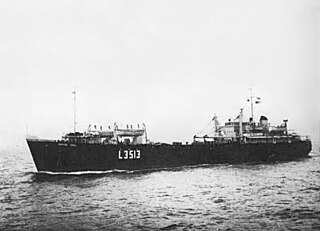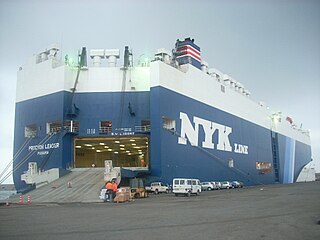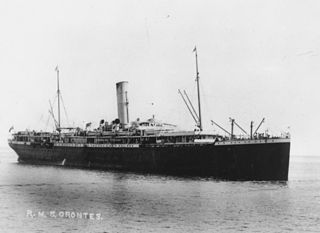
RFA Empire Gull (L3513) was a landing ship, tank of the Royal Fleet Auxiliary. She was familiarly known as the "Black Pig" and was one of the last serving British LSTs. She was built as LST 3523, one of the Empire Ships, and later commissioned as HMS Trouncer. During the Suez Crisis she was pressed into Government service as SS Empire Gull. In 1970 she was transferred to the Royal Fleet Auxiliary as RFA Empire Gull, serving for ten years before being scrapped.

Landing Ship, Tank (LST), or tank landing ship, is the naval designation for ships first developed during World War II (1939–1945) to support amphibious operations by carrying tanks, vehicles, cargo, and landing troops directly onto a low slope beach with no docks or piers. The shallow draft and bow doors and ramps enabled amphibious assaults on almost any beach.

Roll-on/roll-off ships are cargo ships designed to carry wheeled cargo, such as cars, motorcycles, trucks, semi-trailer trucks, buses, trailers, and railroad cars, that are driven on and off the ship on their own wheels or using a platform vehicle, such as a self-propelled modular transporter. This is in contrast to lift-on/lift-off (LoLo) vessels, which use a crane to load and unload cargo.

LST 3041 was a Landing Ship, Tank that served in the Royal Navy at the end of World War II, before being converted to a commercial ferry. She was later requisitioned by the Navy during the Suez Crisis, and was scrapped in 1960.

The Mark 8 Landing Craft Tank were landing craft tank ships operated by the British Armed Forces. The vessels were based on an American design, but improved into ocean-going vessels capable of sailing to and operating in the Far East.

RMS Orion was an ocean liner launched by the Orient Steam Navigation Company in 1934 and retired from the water in 1963 after carrying about 500,000 passengers. A 23,371 ton passenger ship, the Orion was built to carry 486 first class, 653 tourist class passengers and 466 crew from Europe through the Pacific to Australia. The construction of the ship was documented in Paul Rotha's 1935 film Shipyard.

HMS Cicero was an infantry landing ship in service with the Royal Navy during the late stages of the Second World War.
Empire Cedric was the first ro-ro ferry. She was built for the Royal Navy as the Landing Ship, Tank, HMS LST 3534. She was commissioned in 1945 and converted for civilian use as a ferry in 1948. She was used in the Irish Sea on routes between Preston and Larne, and Preston and Belfast. In 1956, she was requisitioned by the Royal Navy for a few months during the Suez Crisis as HMS Empire Cedric. She served until 1960 when she was scrapped.
Empire Celtic was a ferry which was built in 1945 as Landing Ship, Tank LST 3512 for the Royal Navy. In 1946 she was chartered by the Atlantic Steam Navigation Company Ltd, converted to a ferry and renamed Empire Celtic. In 1956, she was requisitioned by the Royal Navy for a few months during the Suez Crisis as HMS Empire Cedric. She served until 1960 and was scrapped in 1965.
Empire Curlew was a 4,273 GRT ferry that was built in 1945 as LST Mk.3 HMS LST 3042 by Harland & Wolff, Govan, Scotland for the Royal Navy. In 1947, she was renamed HMS Hunter. During the Suez Crisis in 1956, she was transferred to the Ministry of Transport and renamed Empire Curlew. She served until 1962, when she was scrapped.
Empire Cymric was a 4,820 GRT Ferry that was built in 1944 by Harland & Wolff Ltd, Belfast as LST (3) HMS LST 3010 for the Royal Navy. She was transferred to the Koninklijke Marine in 1945, serving as HNLMS LST 3010. In 1947, she was transferred back to the Royal Navy and renamed HMS Attacker. The ship was requisitioned by the Ministry of Transport in 1954 and renamed Empire Cymric. Requisitioned briefly during the Suez Crisis in 1956 as HMS Empire Cymric, she served until 1962, and was scrapped in 1963.

The Atlantic Steam Navigation Company was founded in 1934 with the original object of providing a no-frills transatlantic passenger service. A combination of difficult economic conditions and then World War II frustrated these early ambitions.

RMS Orontes was a steam ocean liner of the Orient Steam Navigation Company that was launched in 1902 and scrapped in 1925.
HMS Tilbury was a S-class destroyer of the British Royal Navy that served during the First World War.

Empire Fulmar was a LST (3) which was built in 1945 by Davie Shipbuilding & Repairing Co Ltd as HMS LST 3524 for the Royal Navy. She was renamed HMS Trumpeter in 1947. She was transferred to the Ministry of Transport in 1956 and renamed Empire Fulmar, serving in the Suez Crisis. She was later laid up in Singapore and was scrapped there in 1969.

MS Europic Ferry was a roll-on/roll-off car ferry built in 1967 by Swan Hunter for the Atlantic Steam Navigation Company (ASN). She was acquired by European Ferries in 1971 when they took over the ASN and served with them under the Townsend Thoresen branding. The Europic Ferry was requisitioned by the British government in April 1982 and transported stores, equipment and troops to the South Atlantic during the Falklands War. After the war she returned to service with European Ferries until that company was sold to P&O in 1987. She was sold again to Namora Shipping in 1993 and served on routes in the Mediterranean until sold for scrapping in 2004.

USS Pima County (LST-1081) was an LST-542-class tank landing ship of the United States Navy. Built by the American Bridge Company in Ambridge, Pennsylvania from 13 November 1944 she was commissioned into the navy on 30 January 1945. LST-1081 saw service as a logistics vessel in the latter stages of the Pacific War but was placed into reserve and decommissioned after the war. She was recommissioned in 1950 after the outbreak of the Korean War and served with the Atlantic Fleet, including a deployment in the Mediterranean Sea during which she was renamed USS Pima County. She returned to the reserve in 1956 and was decommissioned on 12 December of that year.

Empire Gaelic was a ferry which was built in 1945 for the Royal Navy as the Landing Ship Tank, Mk.3 HMS LST 3507. She was converted into a ferry in 1948 and renamed Empire Gaelic, serving on the Preston – Larne route 1949–60, when she was scrapped.












